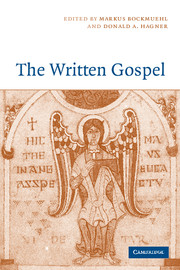Book contents
- Frontmatter
- Contents
- List of contributors
- List of abbreviations
- Introduction
- PART I BEFORE WRITING
- PART II WRITING THE FOUR GOSPELS
- 5 Who writes, why, and for whom?
- 6 How Matthew writes
- 7 How Mark writes
- 8 How Luke writes
- 9 How John writes
- 10 Beginnings and endings
- PART III AFTER WRITING
- Appendix: Graham Stanton's publications
- Bibliography
- Index of ancient sources
- Index of authors
5 - Who writes, why, and for whom?
Published online by Cambridge University Press: 07 December 2009
- Frontmatter
- Contents
- List of contributors
- List of abbreviations
- Introduction
- PART I BEFORE WRITING
- PART II WRITING THE FOUR GOSPELS
- 5 Who writes, why, and for whom?
- 6 How Matthew writes
- 7 How Mark writes
- 8 How Luke writes
- 9 How John writes
- 10 Beginnings and endings
- PART III AFTER WRITING
- Appendix: Graham Stanton's publications
- Bibliography
- Index of ancient sources
- Index of authors
Summary
INTRODUCTION
Three basic questions arise with regard to any attempt at communication: Where does it arise from? Where is it directed? and What is being communicated? Such a model of communication theory, often associated with the name of Roman Jakobson (1896–1982), stresses the importance of analysing the transmitter, message and receiver for anything one person is communicating to another. Thus one can speak of a TV transmitter or station which sends out a broadcast which television sets (equipped with the right aerial, cable or satellite dish) can receive and decode so that the programme can be played. A troupe of actors who perform a play before a live audience are using the same process, albeit with a different medium.
For written communications, these three basic elements can be worked out in various forms around the model of author–text–reader, as when someone writes a letter for someone else to read. Naturally, this three-fold understanding applies much more widely than just to letters – it applies to poems, plays, books, stories: somebody has to produce them, and someone has to read them. Of course, the ‘author’ may involve a lot more than just the one who writes; there may be several authors or editors involved in the production of the text, and still others in its delivery or transmission. Meanwhile at the other end of the process, our use today of the term ‘reader’ must not blind us to the fact that personal, silent reading ‘within the head’ is relatively modern.
- Type
- Chapter
- Information
- The Written Gospel , pp. 99 - 115Publisher: Cambridge University PressPrint publication year: 2005
- 3
- Cited by



